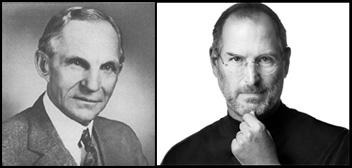 Since the unfortunate loss of Steve Jobs last year, numerous business and technical news sources have been honoring his memory by giving an account of all the innovations he has brought to both home users and businesses around the world. From the first user-friendly personal computer to the revolutionary iPhone that made smart phones a household word, Jobs has left an indelible mark upon the world that will last for many years to come.
Since the unfortunate loss of Steve Jobs last year, numerous business and technical news sources have been honoring his memory by giving an account of all the innovations he has brought to both home users and businesses around the world. From the first user-friendly personal computer to the revolutionary iPhone that made smart phones a household word, Jobs has left an indelible mark upon the world that will last for many years to come.
Innovations Before The Internet
World-changing innovations from America did not begin with the Internet Age, however, because the nation has long been a fertile ground for independent inventors. During the Colonial Period, for instance, Benjamin Franklin developed the first swimming flippers, the lightning rod and the flexible catheter. After the war for independence was won, Eli Whitney invented the cotton gin, which made the cotton industry of the South a giant by enabling farmers to mass-produce their product.
Industrial Innovations
The Industrial Revolution became an especially productive period of invention for America. Thomas Edison, the greatest inventor of all time, patented over a thousand inventions, including incandescent light bulbs, motion pictures and the phonograph. This period also gave rise to Alexander Graham Bell, who designed the first telephone in 1876, and Charles Goodyear, who was responsible for the discovery of vulcanized rubber. These were only a few of the many inventors who made their homes on American soil at that time.
Automotive Innovations
The turn of the 20th century ushered in the Automotive Age, in which American innovators also played a major role. Although the very first steam and gas-powered “horseless carriages” appeared in Europe first, they were unreliable and too expensive for the average citizen. When Henry Ford introduced his assembly line to mass-produce his Model T in 1908, however, he created a vehicle easy enough to purchase and repair that Americans who had never had a chance to drive could own their first automobile.
Widespread Adoption
The Model T became an immediate success, and by 1918 it represented half of all the cars on the road in America. Ford also used his immensely important manufacturing technique to provide a better life for farm workers by designing tractors they could easily afford. Like the Model T, the Fordson Tractor quickly replaced horse-drawn vehicles by becoming less expensive to maintain.
Self-Starting Engines
American automotive innovators not only made driving easier on the pocketbook, but were also responsible for many of the comforts that are now taken for granted. Early automobiles had to be hand-cranked before they would start, which was both a tedious and dangerous task. Although the French designed a self-starter powered by compressed gas, it was too unreliable for regular use. Charles “Boss” Kettering of General Motors, however, invented the first reliable self-starter for the 1912 Cadillac, which only the internal combustion engine surpasses as one of the greatest automotive innovations in history.
Keep A Classic Running Smoothly
The fact that many of these examples of automotive ingenuity are still up and running is a testament to quality American design. Perhaps you already own one of these cherished beauties and would like to ensure that it will last for years to come. At CDmanuals.net, you can purchase an original car owners manual for all American-made vehicles up until 1990. These repair manuals are not only factory-issued for dealership mechanics, but are also available for immediate access via another world-changing American invention – the Internet.
About the author: Brandi Tolleson is a prolific writer living in Whittier, California.